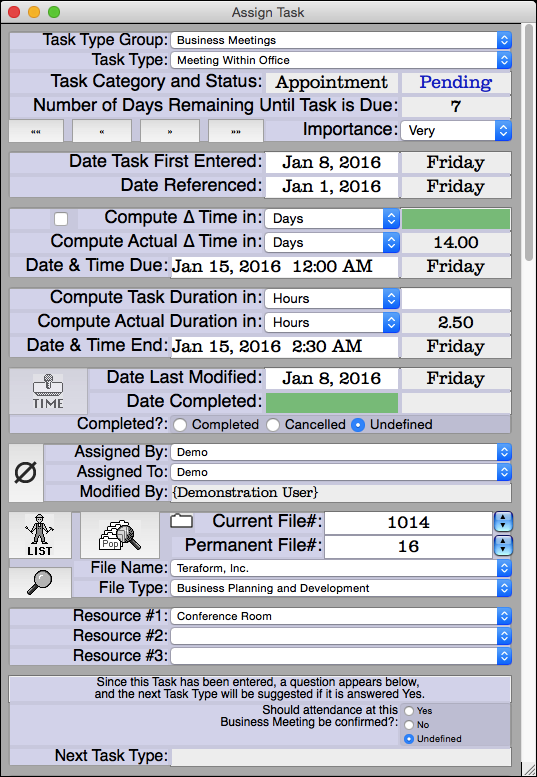Task Management
Main Feature Set
Task Management
Managing Partner integrates a comprehensive and highly flexible system of Task Management which fulfills a broad range of needs regarding the performance of Tasks over time. This includes the management of Tasks ranging from anything which must be done at some unspecified time in the future, to an appointment with a particular due time and end time which is related to a particular Case File and requires the utilization of up to three shared Resources such as a conference room or portable computer. Task entry type views are dynamic, and automatically re-configure depending upon the Type of Task and the data being entered. A Task is automatically categorized as a Thing to Do, Reminder, Assignment, or Appointment, depending upon the field values entered by the User. If an end time for the performance of a Task is entered, the Task is categorized as an “Appointment,” and it becomes impossible to create scheduling conflicts for shared Resources or the User to whom the Task is assigned.
The Pending Appointments Calendar view can display appointments which run across multiple days. The several calendar views are particularly useful for scheduling appointments since open time periods are displayed. The top portion of the Assign Task view is shown below as it appears when displaying a Pending Appointment with an allocated Shared Resource.
Tasks are organized by a descriptive Task Type selected from a pop-up menu on Task entry type views, and the Administrator assigns each Task Type to a Task Type Group. These group assignments are dynamic, and the Administrator may reassign Task Types to new or different Task Type Groups at any time. Task Types may be configured extensively by the Administrator, and may include rules for computation of a default or maximum Date & Time Due, whether a User may override a maximum Date & Time Due, a Custom Label to be displayed for the Date Referenced field, and a default Task Description. The Administrator can compel Users to edit or supplement the default Task Description by typing a space at the end of the default text. Alternative Next Tasks to schedule upon completion can also be suggested. In this way, complex procedures or rules can be taught to Managing Partner which can then serve as the command and control center for the entire firm.
Tasks may be Assigned By one User to another User, yet entered by a third User, enhancing flexibility. To maintain accountability, the identity of the User entering or last modifying the Task is automatically recorded and displayed on all Task entry views. Additionally, the Administrator may configure Managing Partner to maintain a complete Audit Log of each entry or modification of any Task within specified Task Type Groups.
To assist Users when entering or editing Tasks, two date and time calculators are incorporated into the Task entry views. The first calculator is used to calculate the difference in time between a Date Referenced and a Date & Time Due, or to compute a default Date & Time Due based upon a specified difference in time from the Date Referenced. This difference in time is referred to as the ∆ Time Until Due. (∆ is the Greek letter “Delta,” and is used as a mathematical symbol to represent “difference.”) This first calculator can compute time in fractional Days or Weeks, or in whole Months or Years. The second calculator is used to calculate the Duration of an Appointment, or to compute a default Date & Time End based upon a specified Duration. This calculator can compute time in fractional Days or Weeks. The actual difference in time between the Date Referenced and the Date & Time Due is always displayed above the Date & Time Due fields. This Actual ∆ Time is computed using the Actual ∆ Time Units selected from the pop-up menu for this field. Fractional Months and Years are computed based upon the actual number of days within the months in the time period being measured. Therefore, for example, an Actual ∆ Time of 6.00 months will always be equal to 0.50 years.
The lower portion of the Task entry views displays two large scrolling text fields. The first is for entry of the Task Description by the User assigning the Task, and the second is for any Progress Notes entered by the User to whom the Task has been assigned. Like Comment fields in other records, these Description and Note fields are keyword indexed permitting optimized searches for Tasks containing particular words entered in these fields.
Task Views

Task Types and Type Groups
Task Linked Users and Log
Task Date & Time Calculators
Task Description and Progress Notes